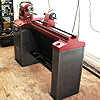Jim,
I generally agree with everything you said and my finish stone for most things is an 8K Norton. I strop with leather and .5 Micron diamonds. But a couple of years ago I had an epiphany about Japanese natural water stones.
Over the years I've purchased a number of Japanese chisels, including some high end ones made by Chutaro Imai. Several people I respect encouraged me to get a good natural "polish" stone for these chisels. I was put off by the price of the things, but I went ahead and asked Kayoko to keep her eyes open for a stone for me. I didn't hear from her about the stone for 6 or 7 months and I'd frankly forgotten I'd discussed it with her. She called me one day excited and told me she'd brought a natural Honyama polish stone back from Japan for me and it was "wonderful." She clearly recalled that I'd committed to buy a stone. When she told me how much it cost, I almost fainted. Nevertheless, it was apparent to me that she had acquired the stone for me and expected me to purchase it. I sucked it up and sent her a check. If you've ever done business with Kayoko, you would understand why I couldn't disappoint her. The stone arrived and I used it on my best Imai slicks. Up to that time I'd been sharpening them as I do everything else - up to 8K with the Norton and stropping with the leather strop and diamond paste.
I can tell you that I was amazed at the edge I got from the Honyama stone. It is an order of magnitude finer than any edge I'd been able to achieve on any tool up to that point, and the edge lasted a long time. I no longer strop these chisels, I keep the stone handy and touch up my edges while I'm working. It really is a different experience. But it only works on the very hard edge of my laminated Japanese blades. It makes no noticeable difference on any Western chisel in my kit. Like you, I was not a believer in the Japanese natural stone mystique. Had it not been for my big mouth and a misunderstanding, I probably would still be a nonbeliever. But, having used this stone, it is clear that it makes a noticeable difference in the edge quality and fineness on my Japanese chisles.
Hank





 Reply With Quote
Reply With Quote




